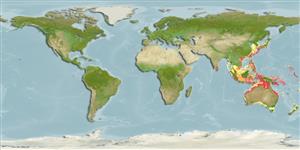Environment: milieu / climate zone / depth range / distribution range
Ökologie
seewasser demersal; tiefenbereich 13 - 78 m (Ref. 9494), usually 15 - 25 m (Ref. 9774). Tropical
Indo-West Pacific: Indo-Australian Archipelago.
Size / Gewicht / Alter
Maturity: Lm ? range ? - ? cm
Max length : 25.0 cm SL Männchen/unbestimmt; (Ref. 9774); common length : 17.5 cm SL Männchen/unbestimmt; (Ref. 9774)
Rückenflossenstacheln (insgesamt) : 0; Rückenflossenweichstrahlen (insgesamt) : 67 - 72; Afterflossenstacheln: 0; Afterflossenweichstrahlen: 51 - 55. Body brownish, 2 double or tripe ocelli above and below lateral line and 1 on posterior third of straight section of lateral line. Many dark spots and rings scattered on body and median fins. Pectoral fin on ocular side with 12-13 rays. Pelvic fins short based, subequal and sub symmetrical in position, posterior 3-4 rays branched.
Inhabits muddy and sandy bottoms (Ref. 9774). Feeds on small benthic animals (Ref. 9774). Caught mainly with bottom prawn trawls (Ref. 9774).
Life cycle and mating behavior
Maturities | Fortpflanzung | Spawnings | Egg(s) | Fecundities | Larven
Distinct pairing (Ref. 205).
Kailola, P.J., 1991. The fishes of Papua New Guinea: a revised and annotated checklist. Vol. III. Gobiidae to Molidae. Research Bulletin No. 41, Research Section, Dept. of Fisheries and Marine Resources, Papua New Guinea. 153 p. (Ref. 6771)
IUCN Rote Liste Status (Ref. 130435)
Bedrohung für Menschen
Harmless
Nutzung durch Menschen
Tools
Zusatzinformationen
Download XML
Internet Quellen
Estimates based on models
Preferred temperature (Ref.
123201): 24.5 - 29, mean 28 °C (based on 310 cells).
Phylogenetic diversity index (Ref.
82804): PD
50 = 0.5000 [Uniqueness, from 0.5 = low to 2.0 = high].
Bayesian length-weight: a=0.00741 (0.00343 - 0.01604), b=3.17 (3.00 - 3.34), in cm total length, based on LWR estimates for this Genus-body shape (Ref.
93245).
Trophic level (Ref.
69278): 3.5 ±0.37 se; based on food items.
Widerstandsfähigkeit (Ref.
120179): hoch, Verdopplung der Population dauert weniger als 15 Monate. (Preliminary K or Fecundity.).
Fishing Vulnerability (Ref.
59153): Low vulnerability (21 of 100).
